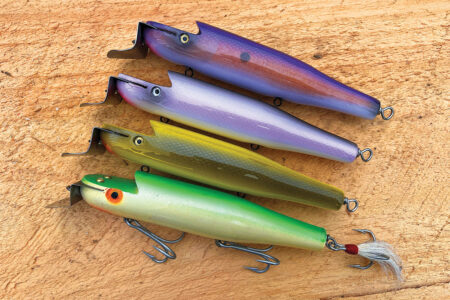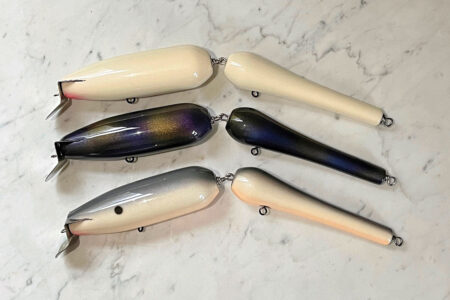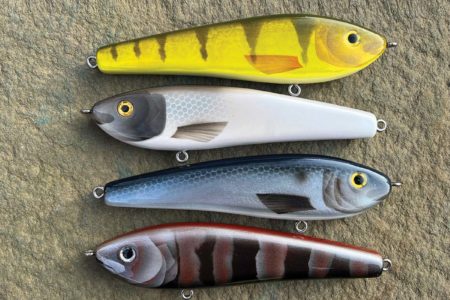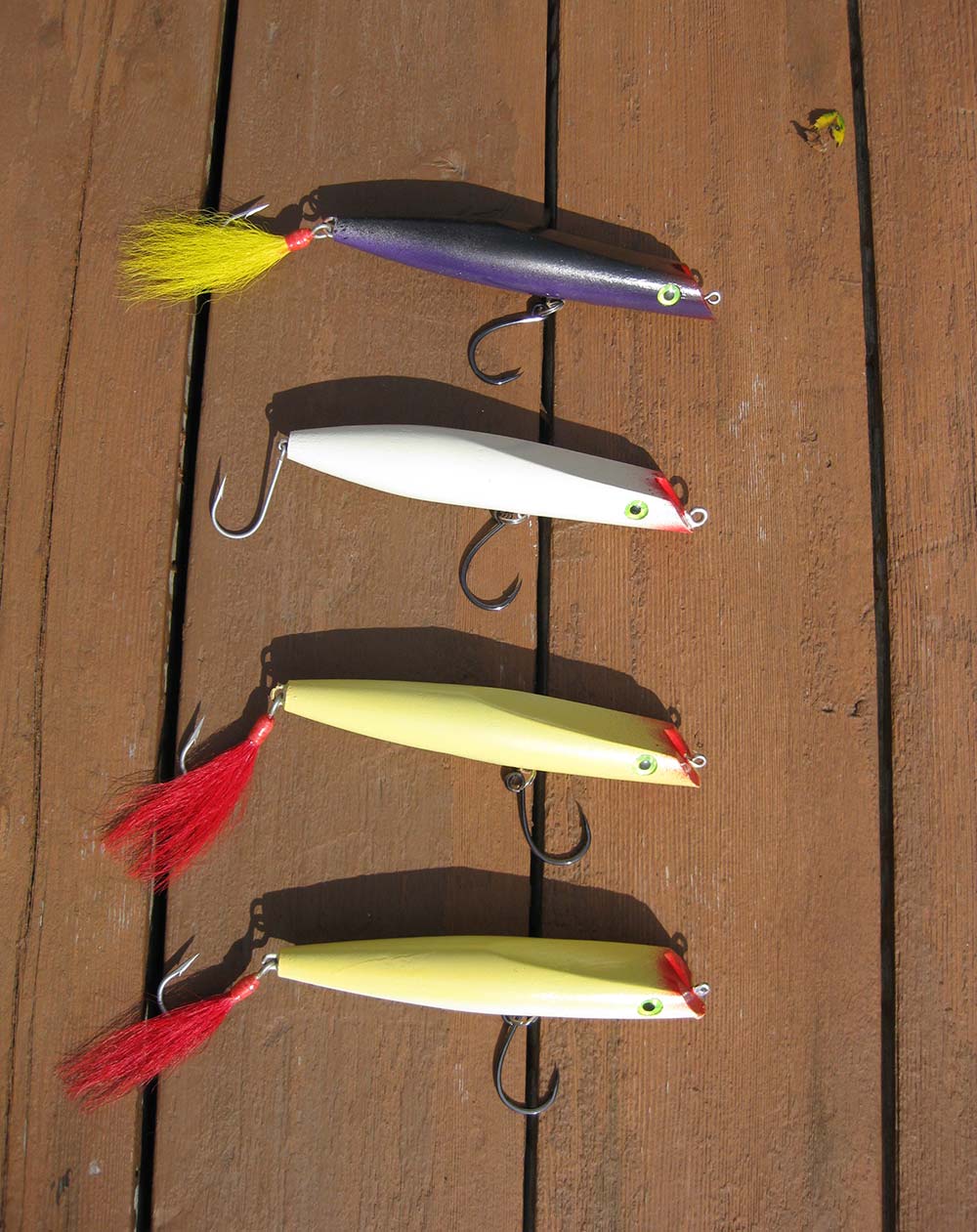
All you need to know to get started building one of the Striper Coast’s more popular striped bass plugs.
One day in the early part of the 1950s, Johnny Kronuch received a package at his Montauk tackle shop. It was from Stan Gibbs in Buzzards Bay, Massachusetts. The package contained a number of plugs in various colors of a new design which Stan called a darter. He asked Johnny, who was an accomplished surfcaster, to let some Montauk “regulars” try out the plug during the fall bass run. John passed the plugs around and the results were fantastic! He called Stan and told him that this new plug was a winner and said he could sell all that Stan could make. A star was born and as the story goes, “the rest is history.”
The Gibbs D2-1/2 ounce darter became the go-to plug of all serious surfcasters at Montauk, and eventually up and down the Striper Coast. Nothing could match it for nighttime bass fishing, until possibly the advent of the needlefish plug, some 30 years later.
Many plug makers throughout the Northeast began turning out their own version of the darter, a plug with near neutral buoyancy and a slight side-to-side darting action when retrieved slowly in moving water. Far and away the most successful version of this plug is the Super Strike Zig Zag Darter developed in plastic by legendary plug maker Don Musso.
In recent years, another design, the Mag Darter manufactured by Yo-Zuri, also gained favor with the surf crowd. Many of Yo-Zuri’s injection molded plastic lures, as well as plugs made by Daiwa and Shimano, employ a movable internal weight system. When the plug is cast, the internal weight is in the rear of the plug and when retrieved, the weight moves more to the center of the plug. This is accomplished by a system of magnets or springs, depending on the manufacturer, and is based on the principal of centrifugal force. Builders of wooden plugs can’t duplicate this system, but we can make the plug cast just as well or better by increasing the lead weight.
The two darter versions I build come in at 2-3/4 ounces and a little over 3 ounces, and the head of these plugs mimics the design of the aforementioned Mag Darter by Yo-Zuri. Naturally, to maintain neutral buoyancy the heavier plug requires slightly more mass.
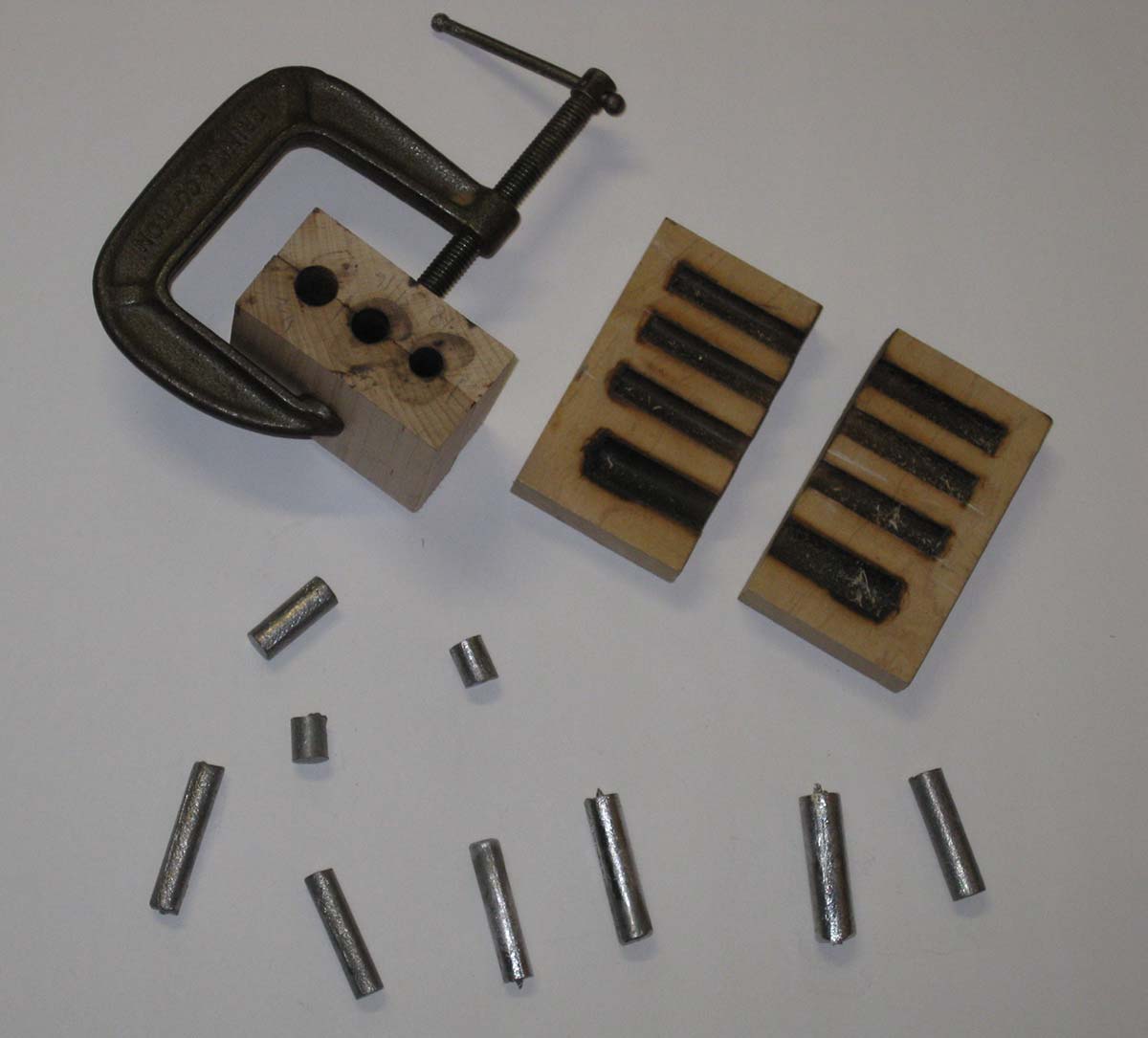
Materials List
Before I get into the details of making this plug, I would like to share some info with those readers who are new to plug making. Those of you that are already making plugs can disregard this paragraph. First, a wood lathe is a must. A new bench wood lathe can be purchased at Harbor Freight for $260, and used ones can be picked up at a much lower price. You can buy a higher end one but you don’t need it unless you want to get into other aspects of wood working. Along with the lathe, you will need two hand held cutting tools: a 1/2-inch gauge and 1/2-inch skew. Next comes a workbench with a vise, and a 1/4 or 3/8 power drill along with a set of drill bits (brad point style is preferred). Then comes what you would like to have and number one would be an 8-inch drill press with a drill press vise; Harbor Freight sells one for under $70.
There are various types of wood that can be used, and many builders have strong opinions about this subject. Stan Gibbs in the early years used white pine, while others swear by more exotics such as Alaskan yellow cedar or basswood. Further, some builders use plain red cedar or even the heavier maple in certain applications and plug types. After being in this game for many years, my favorite is poplar, and I have used them all. It is classified as a hardwood but is the least hard of all the hardwoods. Basswood is not expensive, easy to find, and works well on the lathe. Big box hardware stores like Lowes and Home Depot sell poplar dowels for approximately $5 for a 4-foot length in various diameters from 1/2-inch up to 1-1/2 inches.
Be aware, and this is important, that lead weight is not too critical for pencil plugs, poppers or needlefish plugs, but it is for darters, which work best at neutral buoyancy. The amount of lead that I recommend is for use with poplar based on testing in saltwater, but if you use a softer, lighter wood, the amount of lead must be slightly increased. Conversely, a heavier, denser wood requires a reduction in lead.
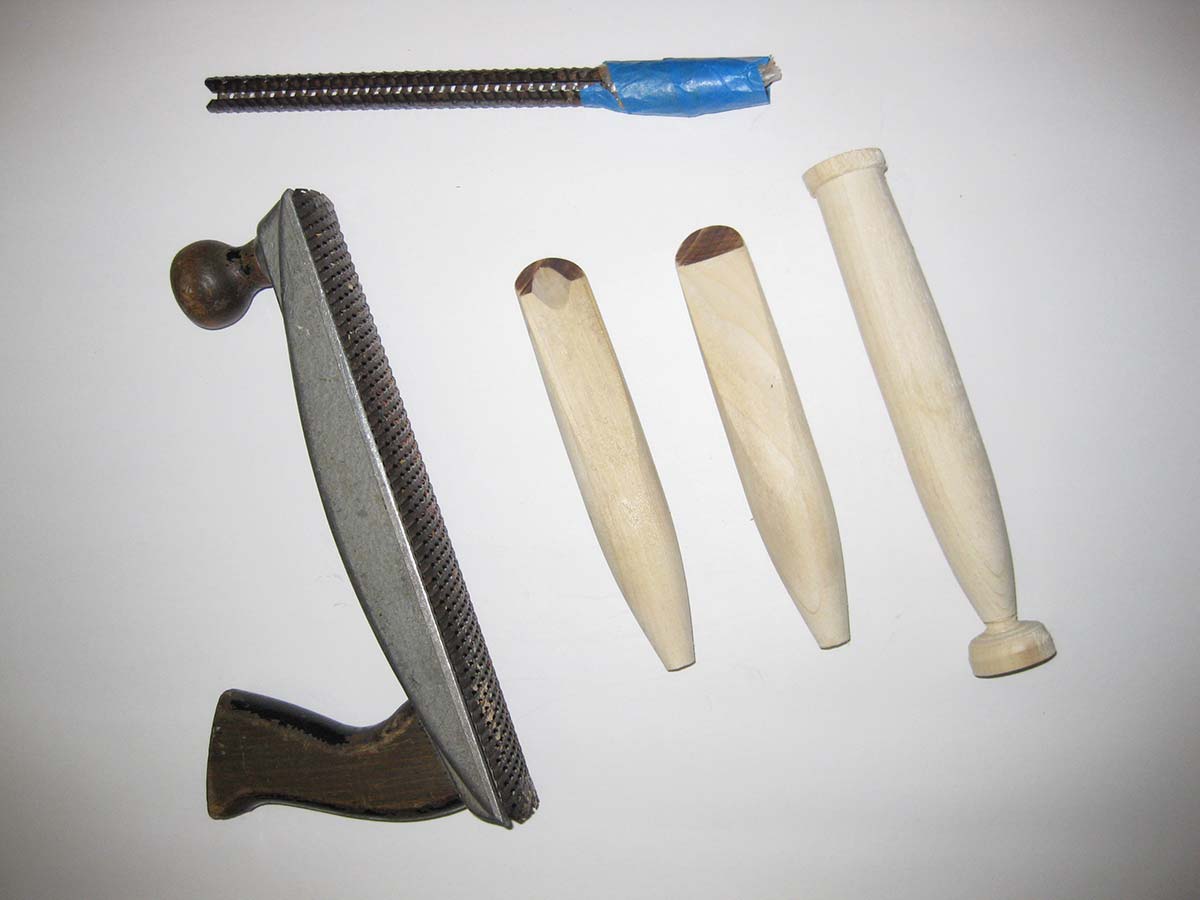
Start Turning
Before firing up your lathe, cut an 8-inch long, 1-1/4-inch diameter dowel and drill the necessary pilot hole for setting it up for mounting. Depending which version you are making, turn the dowel to 1-1/8 or 1-3/16 outside diameter. With a pencil, mark the center of the length and turn the tail section down to 3/8 diameter and the front section down to 1 inch. With the lathe spinning, sand the plug smooth starting with 100 grit, then 150 and finish with 220 grit for a smooth finish. Remove the plug from the lathe and cut a 45- degree slope in the front as noted in the diagram. Place the plug in a vise and shave the top slope on the plug. For this you can use a block plane, but I much prefer to use a Stanley sure-form half round blade (shown in the photo). Once the slope is cut, sand it smooth with the same grits previously recommended. Note: If you are using a vice with metal jaws, place two small pieces of wood about ¼-inch thick on either side of the plug to prevent distortion and marking of the softer material.
We are now ready to drill holes for the lead weights and the three screw eyes. This version of the plug is not of “through-wire” construction. When I make plugs such as the needlefish, where the front and back hardware are in a straight line, I always use a through-wire. Here that is not the case, and I prefer to use ¾-inch long, .072 diameter stainless steel screw eyes. I have strength tested them, and 50-pound weights will not dislodge them so you should be fine with most any bass you’re likely to encounter in the surf. The holes for the screw eyes are 1/16 diameter (do not drill a smaller or larger hole). an alternate method is to use brass eyes used when pouring pyramid sinkers. They can be epoxied into a ¼-inch drilled hole and are very strong.
Many plug builders buy lead weights through places like NJ Tackle or other plug building outlets, but I pour my own lead weights as shown in the photos. I pour 3/8-, 7/16-, and ½-inch diameter weights and cut them into various lengths. From there I experiment in saltwater to decide on the size weight that gives me the buoyancy and action that I want. When I make a batch of plugs I pour molten lead into the plug drilled hole which matches the pre-determined weight. I find this technique much more efficient than using epoxy to seal in the lead weights. The hole for the lead weight is ½-inch diameter. With a brad point drill bit, drill these holes to a depth of 9/16 or 5/8, depending on which version you are constructing.
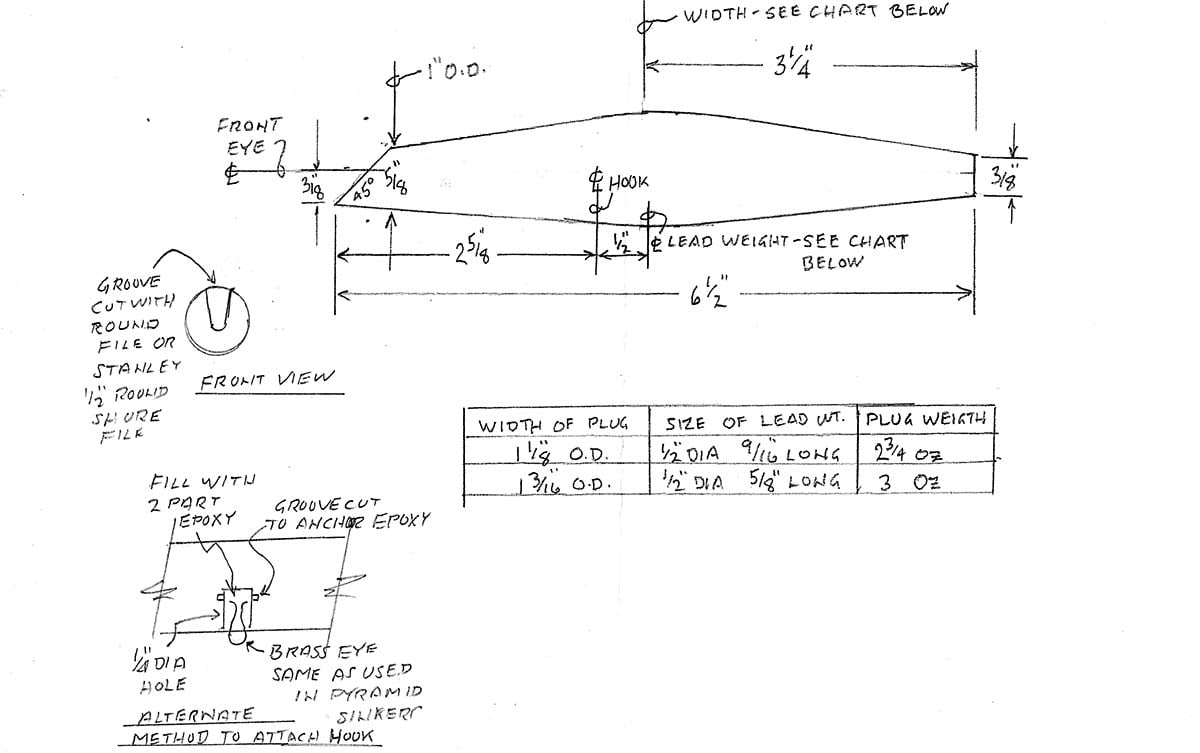
Finally, I seal my plugs by submersing them in boiled linseed oil for about 20 minutes before drying them in the sun for a few days. Once fully dry, I use two coats of spray can paint followed by two coats of clear gloss spray. As far as hooks go, most casters opt for a 4/0 treble for the front and a 4/0 or 5/0 Siwash single hook for the rear. Some casters favor single in-line hooks front and back to make catch and release easier. As always, in this age of catch and release, it is always best to bend the barbs down, especially in the case of trebles.
So there you have it; plug making is a great off-season activity, and catching fish on something you have made yourself is especially satisfying. Do your part to conserve our valuable striped bass resource, and remember that darters work best at night and in moving water.

